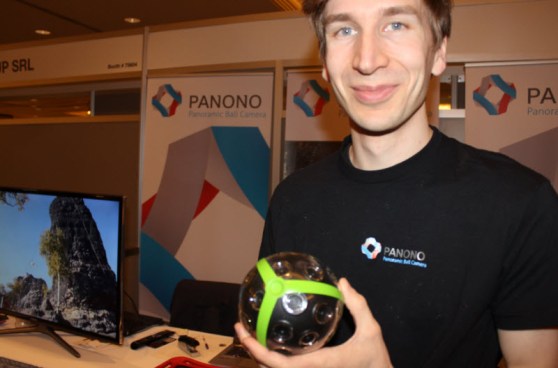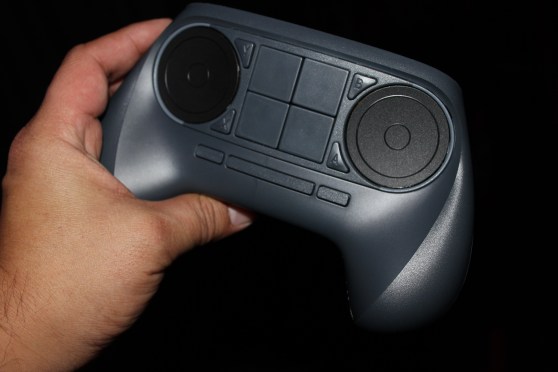Every year, the electronics and computer industries gather in Las Vegas for International CES, a gigantic tradeshow where they show off their wares for the coming year.
Getting through the 2014 International CES wasn’t a cake walk. We trudged for miles inside overheated convention halls, braved buffet lines, and saw some spectacular demos. We tried to see as many of the products as we could among the 3,200 exhibitors, and we did combat with the 150,000 attendees who were trying to butt in front of us in lines.
We survived CES, just barely, with 50 percent of our staff leveled by convention illness. But despite that heavy attrition rate, we’ve come up with our view of what we liked best at CES. These are the products we are most looking forward to in the coming year.
By comparison, here’s our list from last year’s CES.

Above: Aaron Davies, head of developer relations at Oculus.
Oculus VR’s latest demo of its Oculus Rift headset
Virtual reality can make you seasick. Oculus VR has been fighting this conventional wisdom for the past couple of years and it is now doing something about it. With its latest “Crystal Cove” demo of its virtual reality goggles, the Oculus Rift prototype felt pretty good. The demo featured positional tracking, so you could now move your head about in any direction, and low persistence, or some technical tricks that eliminate motion blur when you turn quickly. Both of these features take the experience one step closer to true virtual reality and a gaming platform that you can enjoy for more than a few minutes. Oculus still has a way to go. But it has generated a lot of interest from the gamer and developer communities because it offers cool new technology that brings something different to the table. — Dean Takahashi

- Sony CEO Kazuo Hirai shows off its dreamy new short-range 4K projector
Sony’s short-range 4K projector
While Sony CEO Kazuo Hirai only briefly mentioned this gadget during his CES keynote, it instantly got my mind spinning. It’s a projector that you can place right up against a wall or screen to produce a giant, glorious 4K image. Unlike traditional projector setups, you won’t have to deal with a complicated installation or people jumping in front of the projected image, because it sits so close to the wall.
The problem? It’s going to cost you $30,000 to $40,000 when it’s released this summer.
Expect that cost to fall dramatically over time, though. Once short-range projectors are inexpensive and readily available, there won’t be much of a need for 4K TV sets. — Devindra Hardawar

Nvdia’s Tegra K1 mobile processor
Mobile computing and graphics are moving on an accelerated path, and that was evident at Nvidia’s press conference, where it unveiled the Tegra K1 mobile processor. This chip has 192 graphics cores and had both a 32-bit and 64-bit version that could run games based on Epic’s Unreal Engine 4 game engine. That means that mobile devices will be able to run state-of-the-art games that are designed for today’s consoles and PCs.
In demos, Nvidia showed that it could run the finest visual effects like translucency, high-dynamic range (cool lighting and shadows), water warping, realistic glowing skin in human characters, and more. In creating Tegra K1, Nvidia is closing the gap between what the best consoles can do and what the best mobile devices can. Already, the Tegra K1 has faster performance than a PlayStation 3 or an Xbox 360.
This kind of technological advance lays the foundation for developers to create a whole collection of exciting new games. — Dean Takahashi

Above: Jonas Pfeil of Panono, which makes a ball that shoots 36 pictures at once.
Panono’s 36-image 360-degree panoramic camera
Panono is a clever way to capture a new kind of 360-degree panoramic image. It is a ball with protective casing and 36 cameras pointing in all different directions. You toss it in the air and each camera snaps a photo when the ball reaches the highest point in its trajectory. Then it sends all 36 photos off to the company’s servers, which stitch it into a panoramic image that you can view on your smartphone.
The picture resolution will be 108 megapixels, and it will take pictures with features including high dynamic range (HDR), a term for images with both bright and shadowy details at the same time.
The company just raised $1.25 million on Indiegogo, blowing past its goal of $900,000. It will debut in September for $499 for campaign supporters and $599 for everyone else. — Dean Takahashi

Above: Valve’s Steam Controller with trackpads that replace thumbsticks. It makes it possible to play PC games in the living room. #CES2014
Valve’s Steam Controller
Valve, the owner of the Steam digital game distribution service and the maker of Half-Life, launched its Steam Machines living room game console project with 13 partners at CES. The company is making its own Linux-based Steam OS to run Steam-based games. But at the heart of its effort is an innovative game controller. The controller gets rid of the dual analog sticks in favor of two track pads with tactile concentric rings. It enables PC gamers to comfortably play mouse-and-keyboard games with a controller on a big-screen display in the living room. If gamers take to it, then Valve can start converting its 65 million Steam customers to play games in a new part of the home. And that will provide some much-needed competition in game consoles. — Dean Takahashi

